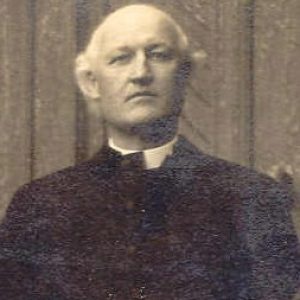calsfoundation@cals.org
William Montgomery Brown (1855–1937)
The colorful William Montgomery Brown was consecrated as the assistant bishop of the Diocese of Arkansas on June 24, 1898, and soon became bishop after the death of Henry Niles Pierce. In 1925, after openly embracing materialism and communism, Brown became the only bishop in the Episcopal Church ever removed from office because of heresy. These heretical views were presented in his book Communism and Christianism: Banish Gods from Skies and Capitalists from Earth.
William Montgomery Brown was born on September 4, 1855, on a farm west of Orrville, Ohio, the son of a maid, Lucina Elzina Cary, and a day laborer, Joseph Morrison Brown. He had a sister and a brother. He became an orphan during the Civil War and was taken into a kindly farmer’s home. In 1879, he met Mary Scranton Bradford, the social scion of Cleveland, Ohio; she sponsored his education as an Episcopal clergyman, and, in 1883, he became vicar of Grace Church in Galion, Ohio. Brown married Bradford’s daughter Ella in 1885 and thus acquired position and wealth. The couple never had children. In 1891, he became the archbishop for missionary work in the Diocese of Ohio and wrote his famous and popular The Church for Americans, which catapulted him into the national spotlight. Consecrated as the assistant bishop of Arkansas in 1898 after a highly contested election, he succeeded to the bishopric after the death of Henry Niles Pierce, the elderly diocesan.
Dictatorial as bishop, he succeeded in greatly increasing the number of churches and parishioners from the years 1899 to 1911. His unique plan of financial support—in which the national church provided one half of the amount needed to expand the diocese and the local people provided the remainder—foundered, however, and most of the new churches soon were defunct. His 1907 book The Crucial Race Question, which pandered to the views of segregationists, greatly angered the Northerners who usually contributed substantial sums to support his poor diocese. Brown appointed an African-American man, George Alexander McGuire, to head a black Episcopal church in Arkansas. (After leaving the state, McGuire became chaplain to Marcus Garvey’s United Negro Improvement Association in New York in 1918, and, in 1921, the head of the African Orthodox Church.) Brown created the Helen Dunlap School for Mountain Girls and a seminary to train a local ministry in Arkansas. From 1909 to 1910, he engaged in a sharp conflict with Trinity Cathedral in Little Rock (Pulaski County) over the issue of control over the cathedral and the refusal of the dean to read and compliment the bishop’s new book, The Level Plan of Church Union. This dispute further alienated many in Arkansas. The Level Plan rejected many practices of the Episcopal Church and angered many supporters, who promptly insisted he leave. In 1911, he returned to Galion, Ohio, and formally resigned as bishop of Arkansas in 1912, although he remained a bishop without a diocese.
From 1911 to 1920, Brown struggled with a loss of faith. He began reading Charles Darwin and those who espoused a materialistic view of the world. His concepts came from the Rationalist Association of Johnson’s Court in London, England, and the Open Court Publishers of Chicago, Illinois, whose books influenced his rejection of supernaturalism. After two years of reading and thinking, Brown announced his “conversion to science” in July 1913. He was now a heretic and radical and wanted to get rid of the sin of hypocrisy by openly confessing his heresies to the brethren in the clergy and among the laity. He wrote to bishops in the Episcopal Church telling them of his “new” position. He said his new faith came from “naturalism” or from observation of plant and animal life. He rejected the historical Jesus and suggested that Jesus was an idea that existed before any attempt to depict such a historical personage occurred. Most bishops ignored him.
His second major conversion was to Marxism, which provided the basis of the second half of Communism and Christianism: Banish Gods from Skies and Capitalists from Earth. Brown argued that the class struggle came from different “levels” in society just as the different churches were “levels” of approaches to religion (a corollary to his arguments in The Level Plan of Church Union). The only reasonable outcome would be a single class, the proletariat, just as in religion there could be only a single church, a Protestant one. He made the communist cause his own and had inscribed in the concrete walkway from his house to his office, “Labor gave us this nest.”
Brown published Communism and Christianism in 1920. The book caused an uproar in the Diocese of Arkansas and then nationally in the Episcopal Church. Brown insisted his views were logical and that he should remain in the church, but most fellow bishops thought him deranged. Under the influence of church conservatives, they tried him for heresy. This event presaged the more famous “Scopes Monkey Trial” in 1925. Found guilty, Brown was deposed. In the meantime, he had accepted ordination and consecration into the Old Catholic Church to keep his title of bishop.
Thereafter, Brown published several books that put forward his ideas, though most were ghost-written by an English rationalist, Joseph McCabe. Brown died in October 1937. His home in Galion is today preserved just as it was when he died.
For additional information:
Brown, William Montgomery. Communism and Christianism: Banish Gods from Skies and Capitalists from Earth. Galion, OH: The Bradford-Brown Educational Company, 1920.
———. The Crucial Race Question, or Where and How Shall the Color Line Be Drawn. Little Rock: The Arkansas Churchman’s Publishing Co., 1907. Online at http://archive.org/stream/crucialracequest00brow#page/n7/mode/2up (accessed February 9, 2022).
Carden, Ronald. William Montgomery Brown (1855–1937): The Southern Episcopal Bishop who Became a Communist. Lewiston, NY: Edwin Mellen Press, 2007.
Ron Carden
South Plains College
 Communist Party
Communist Party William Montgomery Brown
William Montgomery Brown 




Comments
No comments on this entry yet.